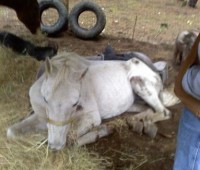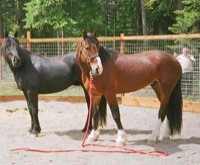When my wife and I arrived at the location, we found a starving horse which had grown so emaciated and weak that he was only able to lie on his side, motionless legs outstretched. I was soon joined at the location, by the volunteer, who received the original call for help. This young woman is exceptionally well-versed in emergency treatment of equines in distress and her caring heart is beyond compare.
As I approached, the horse was lying there on the bare ground. He lifted his head a bit to regard a stranger. He rolled slightly to a more upright position, and for a brief moment tried to resemble his former formidable self. We regarded his skeletal frame, swollen belly and pathetic eyes and the truth was shown to each of us, even though words were not spoken.
The man who owned him showed me a picture of Bailey when he first brought him home, just about five months earlier. Although the horse looked slightly better and was standing in the photo, he was light-years from where he should have been. Bailey’s surroundings told us the story of the ignorance and neglect which had brought Bailey to this day. The owner knew nothing of what a healthy horse requires. He had been sold hay that would be suitable for cattle, but which lacked adequate nutritional value. A small bucket was provided for water, but not enough to provide sufficient hydration. No blanket covered the freezing horse. A makeshift shelter did little to prevent the rain from drenching him.
 |
| Bailey |
Knowing how critical it is to get a horse about to colic up off the ground, we worked diligently to get Bailey to a standing position. Try as we did, we could not get him up but even in his frail condition, he thrashed around and we stepped back, out of range of his badly overgrown hooves. The Vet arrived fifteen minutes after we did, and she immediately administered banamine, electrolytes and other nutrients, which would hopefully give him energy so that he might stand. We saw Bailey’s eyes begin to clear and open a bit wider and although he could not get up, he seemed more alert. We covered him over with materials in the yard - carpet padding, and an old horse blanket. The Vet had a good strong halter, which we hoped would help us to get Bailey on his feet. The Vet began her examination and determined that the horse was suffering from hypothermia and starvation, and these were the true reasons why he could not stand. There were no signs of colic. With a body temperature of 98 degrees, virtually no fat on his bones, and debilitating weakness, he had no chance of survival. The owner agreed and said he wanted the horse put down. When he realized there would be a fee for this service, he said he would just shoot the horse himself. At this juncture, Panhandle Equine Rescue offered to compensate the Vet for the euthanasia.
So, the vials were filled and Bailey received the merciful elixir into his neck. The poor creature was too weak even to exhale a last breath. He simply stopped being. The thick red trickle that issued from his neck was the only evidence of his overwhelming agony. Our hearts broke as we witnessed this scenario, but our solace was in knowing that no one would ever be the cause of Bailey’s suffering again. The dismal dankness of the day was of no consequence to him now.
This story begs the question about tomorrow and all the tomorrows that will follow. It challenges us to ask, what went wrong? This situation had been brought to the attention of the authorities after the neglect had been reported on two previous occasions. But, because of weak laws, lack of knowledge and motivation, or the negligent withholding of adequate care, Bailey suffered and died needlessly.
Positive steps need to be taken to change this ugly story from repeating itself. One of these is education for those who wish to own horses. Panhandle Equine Rescue Inc. is currently in the planning stages of a program which will offer critical instruction to potential and existing horse owners. We are working with our outstanding veterinarians and will begin by holding quarterly telephone conferences which will feature discussions of basic and advanced equine health care issues. The man who owned Bailey knew nothing about horses. He picked up his two horses for “free.” They were malnourished and tragically thin and he thought if he simply fed them they would be fine. He could ill-afford to give those two horses what they needed to survive. Five months later there was only the slightest difference in their appearance and it never occurred to him that things were going wrong. Bailey’s pasture-mate has less than a 50% chance of surviving the winter.
In order to stop needless suffering and death of all animals, action must be taken to first change the laws and then to enforce them. Our research has shown us that the laws in some other states are exceptionally effective and that we do not need to re-invent the wheel here, but only use them as a model for Idaho. Our laws are lax, not because Idaho is void of concern about animal cruelty, but rather because we are operating under only slightly modified archaic laws which go back to a time when Idahoans used their horses for farming, logging and travel. “Back in the day” folks lived by their horses and therefore valued them. Keeping them healthy was a critical priority. In today’s world of “me” and what “I” want, where everything is easily devalued and becomes disposable, we have let our animals fall through the cracks. Idaho is a great state with wonderful, decent people and we need to take appropriate steps by working together to protect our animals.
We recently heard the story of a horse owner in the Bayview area who was confronted by several of his neighbors because during a hot spell he tied horses to the bumpers of his vehicles for hours at a time with just a small amount of water. His angry response was quite telling: “Get off my property and don’t come here telling me what to do. I moved here from Utah so people would stay out of my business. Now go away.” This is a sad commentary, not only on the man’s lack of regard and care, but also on our permissive animal control laws.
In a raid recently launched by the SAC (Spokane Animal Cruelty) group on a person running a puppy mill, they found a horse that had an arrowhead imbedded in his shoulder. It had apparently been there for a very long time and the owner’s attitude was that it would “work its way out.” The story about the horrific conditions found at the puppy mill and the abused horse was never even mentioned in the media and I have specific knowledge that it was reported by several concerned citizens.
Please visit our web site regularly for updates on what we are doing to shake up the status quo. You can sign up for our newsletter and be put on our e-mail list. Become a part of the change!
Please visit
northidahohorserescue.com. Our goal is to bring greater understanding of problems and proposed solutions. We will post and e-mail details of upcoming educational and informative events such as the horse health seminars followed by Q & A sessions with our Vets.
Please consider becoming a member of Panhandle Equine Rescue, Inc. There are many opportunities to help with your involvement, caring and support! Help Us Help Them!
PER is an anti abuse organization and in no way wishes to impugn the integrity of horse breeders, trainers and those with working ranches or commercial riding stables. Many of our members are from agricultural backgrounds and bring the ethics and knowledge from those backgrounds to our organization.
Panhandle Equine Rescue, Inc. (PER) is an all-volunteer, 501c(3) Non-Profit organization dedicated to the rescue, rehabilitation and placement of neglected and abused equine breeds that are legally seized within the Kootenai County & in the State of Idaho, as space and finance allow. To facilitate this mission, our members provide education and information to the general public regarding equine abuse and neglect, which includes Idaho's related animal laws; the basic standard for equine care; how to recognize and report equine abuse, and; how to obtain help. PER's foster program provides shelter, nutrition, veterinary and Ferrier care for those equine breeds under its protection, as well as placement with qualified adopters for those legally seized equine breeds that have been released by their owner (s) or through court action.
Tony Mangan, President, Panhandle Equine Rescue, Inc. is an all-volunteer 501(c)3 non-profit organization. We are very fortunate to have dedicated and concerned officers and members who freely give of their time and their varied expertise in a variety of different ways. Our Board of Directors is made up of a president, vice-president, treasurer, secretary and three directors-at-large. These officers seek to expand the goals of the organization to better serve the community and to efficiently work with the local animal rescue enforcement entities. All of our officers and members fill a variety of roles which include hay hauling, providing foster homes for rescued horses, booth duty at fairs and public functions, hands-on training, providing rehabilitation for abused animals, both socially and physically.

